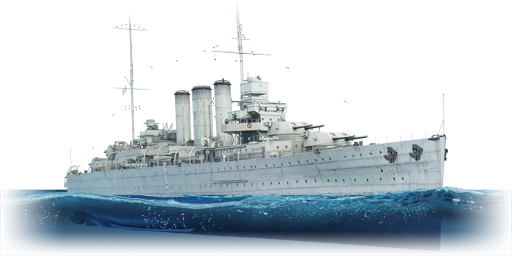The HMS Kent was a County-class heavy cruiser built for Royal Navy in the mid 1920s. She was laid down on 15th November 1924 and commissioned on 25th June 1928. She was armed with four twin 8 inch/50 Mark VIII cannons in superfiring positions with two on bow and two aft. The secondary armament was made of six 4 inch/45 QF Mark V cannons in single mounts on various locations amidship and four 2 pdr QF Mk.VIII autocannons for anti-aircraft protection and two quadruple 533 mm torpedo launchers. After completion, Kent was sent to China where she stayed until the outbreak of WWII when she was tasked with hunting the German pocket battleship Graf Spee in the East Indies together with the French heavy cruiser Suffren and Australian destroyers Vampire and Voyager. In mid 1940, after Italy declared war, Kent was transferred to the Mediterranean where she arrived in August. Two weeks later, she escorted convoys between Alexandria and Malta. During the night of 17 to 18th September 1940, Kent was attacked by Italian S.M.79 torpedo bombers from 279th Squadriglia Autonoma Aerosiluranti. She was towed to Alexandria by destroyers where temporary repairs were conducted before she departed bound for UK. She spent the rest of 1941 undergoing repairs and refitting during which she gained various radars and multiple Oerlikon autocannons. Between 8th and 12nd December 1941, she sailed to Murmansk with British Foreign Secretary Anthony Eden on board. She was assigned to the Home Fleet and escorted convoys bound for Russia until 1944 when she took part in Operation Mascot, covering the carriers performing raids on German battleship Tirpitz in Norway. Kent was put into reserve in January 1945 until being sold for scrap in January 1948.
The Kent was introduced in Update 1.97 "Viking Fury". Her armour protection is very poor for a heavy cruiser with only 25 mm belt armour protecting the machinery and ammo elevators of the turret with 101 mm thick armour plate protecting the magazines. As Kent is in her 1934 fit, she does not possess adequate anti-air protection as the aircraft were not seen as such big threat as later on in the war. The module layout however plays in Kent's favour, as the majority of ship above the waterline is empty so when hit no modules except the ones on superstructure such as secondary weapons or bridge are damaged. All the vital components are located under the waterline being naturally protected from the damage. The 8 inch guns with average fire rate compared to other heavy cruisers possess quite capable penetration capabilities thanks to the SAPBC rounds.














